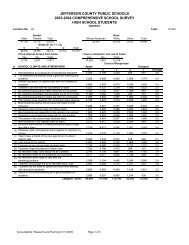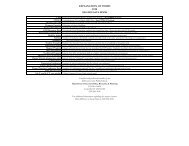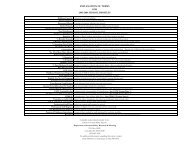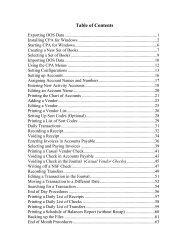Model Procurement - Jefferson County Public Schools
Model Procurement - Jefferson County Public Schools
Model Procurement - Jefferson County Public Schools
You also want an ePaper? Increase the reach of your titles
YUMPU automatically turns print PDFs into web optimized ePapers that Google loves.
<strong>Procurement</strong> Regulations<br />
7.6 Treatment of Specific Cost<br />
7.6.1 Advertising<br />
(a) Advertising costs are those incurred in using advertising<br />
media. Advertising media includes newspapers,<br />
magazines, radio, television, direct mail, trade papers,<br />
billboards, window displays, conventions, exhibits, free<br />
samples and the like. All advertising costs except those<br />
set forth in subparagraph (b) of this paragraph are unallowable.<br />
(b) The only advertising costs which are allowable are<br />
those which are solely for:<br />
(i) recruitment of personnel;<br />
(ii) the procurement of scarce items;<br />
(iii) the disposal of scrap or surplus materials; and<br />
(iv) the listing of a business name and location in a<br />
classified directory.<br />
COMMENTARY: Advertising costs are unallowable because<br />
government sales are generated by soliciting specific<br />
offers for specific requirements. The Board is not subject<br />
to impulse buying, and the advertising costs other than for<br />
those purposes set forth in subparagraph (b) are not allocable<br />
to Board contracts .<br />
7.6.2 Bad Debts<br />
Bad debts include losses arising from uncollectable accounts<br />
and other claims, such as dishonored checks, employee<br />
advances and related collection and legal costs. All<br />
bad debt costs are unallowable.<br />
COMMENTARY: Bad debts are unallowable because it<br />
is presumed that government units always pay their legal<br />
debts, and thus these costs are not allocable to government<br />
contracts.<br />
7.6.3 Contingencies<br />
(a) Contingency costs are any contributions to a reserve<br />
account for any unforeseen costs. Contingency costs are<br />
unallowable except as provided in subparagraph (b) of<br />
this paragraph.<br />
(b) For the purpose of establishing a contract cost estimate<br />
or price in advance of performance of the contract,<br />
recognition of uncertainties within a reasonable<br />
anticipated range of costs may be required and is not<br />
prohibited by this subsection. Further, contributions to a<br />
reserve for self-insurance in lieu of and not in excess of,<br />
commercially available liability insurance premiums are<br />
allowable as an indirect charge.<br />
COMMENTARY: Contingency costs are unallowable<br />
because they are speculative in nature and represent a<br />
mere risk rather than an actual incurred cost.<br />
7.6.4 Depreciation and Use Allowances<br />
(a) Depreciation and use allowances are allowable to<br />
compensate contractors for the use of buildings, capital<br />
improvements and equipment. Depreciation is a method<br />
of allocating the acquisition cost of an asset to periods<br />
of its useful life. Useful life refers to the periods of economic<br />
usefulness in the particular contractorʼs operation<br />
as distinguished from physical life. Use allowances<br />
provide compensation in lieu of depreciation or other<br />
equivalent costs. Consequently, a combination of the two<br />
methods may not be used in compensating contractors<br />
for the use of any type of property.<br />
(b) The computation of depreciation or use allowances<br />
shall be based on acquisition costs. When the acquisition<br />
costs are unknown, reasonable estimates may be used.<br />
(c) Depreciation shall be computed using any generally<br />
accepted method, provided that the method is consistently<br />
applied and results in equitable charges considering<br />
the use of the property. The straight-line method of depreciation<br />
is preferred unless the circumstances warrant<br />
some other method. Investment tax credits taken advantage<br />
of by<br />
a contractor may at the discretion of the Board be considered<br />
in computation of any depreciation or use allowance.<br />
(d) In order to compensate the contractor for use of depreciated,<br />
contractor-owned property which has been<br />
fully depreciated on the contractorʼs books and records<br />
and is being used in the performance of a contract, use<br />
allowances may be allowed as a cost of that contract.<br />
Use allowances are allowable, provided that they are<br />
computed in accordance with an established industry or<br />
government schedule or other method mutually agreed<br />
upon by the parties.<br />
COMMENTARY: When it is economical for contractors<br />
to continue using fully depreciated property and equipment,<br />
they should be encouraged to do so. Failure to allow<br />
contractors to charge the Board contracts with costs for the<br />
use of such property and equipment could serve to encourage<br />
wasteful scrapping and disposal and the incurrence of<br />
administrative and rental costs in excess of the otherwise<br />
allowable use allowance.<br />
7.6.5 Entertainment<br />
(a) Entertainment costs include costs of amusements,<br />
social activities and incidental costs relating thereto,<br />
such as meals, beverages, lodging, transportation and<br />
gratuities. Entertainment costs are unallowable. Refer to<br />
Article XI of these regulations entitled “Ethics and Standards<br />
of Conduct.”<br />
26

















